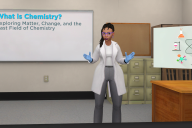You have /5 articles left.
Sign up for a free account or log in.
About half of all colleges report some use of ePortfolios, in which students create a digital archive that tracks their learning progress and demonstrates knowledge and skills gained in college. But are colleges and their students all engaged in best practices? Probably not, suggests a new book, High-Impact ePortfolio Practice: A Catalyst for Student, Faculty, and Institutional Learning (Stylus).
The authors are two educators at community colleges of the City University of New York: Bret Eynon, associate provost of LaGuardia Community College (a pioneer in ePortfolios) and Laura M. Gambino, associate dean for assessment and technology Guttman Community College. Via email, they answered questions about their new book.
Q: ePortfolios aren't new. How are they different these days than in the past?
A: There’s a lot that’s new. ePortfolio technology is becoming more fluid, supporting creative design and visual storytelling. And ePortfolios are increasingly linked with emerging learning technologies, such as digital badges and digital planning and advisement (or IPASS) tools. More importantly, we now recognize that ePortfolio is more than a technology, it’s a technology-aided practice, guided most effectively by integrative social pedagogy. Reflective ePortfolios make student learning visible, creating opportunities for students to integrate their learning and share it with others, in the classroom and beyond. Finally, we now have powerful evidence that demonstrates the impact of sophisticated ePortfolio practice on student, faculty and institutional learning. That evidence was crucial in persuading George Kuh and the the Association of American Colleges and Universities to recently add ePortfolio practice to the list of recognized and validated “High-Impact Practices.”
Q: You both work at community colleges. Are ePortfolios particularly helpful to those in community colleges?
A: The 24 campuses of the Connect to Learning (C2L) network -- the basis of our research on the impact of ePortfolio -- included Research I universities, public comprehensives, and liberal arts colleges, as well as community colleges. Evidence from a constellation of campuses -- from Rutgers University, San Francisco State University, and Indiana University-Purdue University at Indianapolis, as well as LaGuardia, Tunxis and Queensborough Community Colleges -- showed that ePortfolio practice “done well” correlated with improved learning and student achievement (grade-point average), higher levels of retention, and accelerated progress to the degree. Like all high-impact practices, there appears to be a compensatory benefit to “new majority” students, many of whom start in community colleges. But it’s clear from our research that students in many different settings benefit from integrative practices that help them connect education and lived experience, build a greater sense of agency, and engage in processes of what Marcia Baxter Magolda calls “purposeful self-authorship.” That’s the underlying power of integrative ePortfolio practice, and it’s widely applicable.
Q: Many faculty members are dubious of assessment methods that they view as too standardized. How can ePortfolios work in assessment to impress those demanding assessment but maintaining the individuality of courses, instructors and students?
A: Great question. ePortfolio practice can help move assessment past numbers and standardized tests, typically used when assessment focuses on accountability. ePortfolio practice helps to ground assessment in authentic student work, facilitating faculty ownership of the assessment process. Seeing the connection to their own students and their own classroom practice helps build faculty engagement with assessment. Equally importantly, an inquiry process based in this connection expands opportunities for “closing the loop,” helping faculty design and implement changes in practice that actually improve student learning. That’s the bottom line for anyone interested in assessment. In our experience, pairing ePortfolio-based outcomes assessment with the assignment design “charette” process developed by Pat Hutchings and others at the National Institute for Learning Outcomes Assessment (NILOA) can be particularly valuable in deepening these efforts.
Q: How can colleges help faculty members who are new to ePortfolios learn about them?
A: The two word answer is “professional development.” But the value of professional development activity is not limited to faculty who are new to ePortfolios. We found that well designed and broadly inclusive professional development was a crucial indicator for effective ePortfolio initiatives. We all have to work together to invent the integrative social pedagogies that help students connect learning across courses, disciplines and semesters. Professional development that engages faculty with Student Affairs staff and peer mentors is critical to efforts to link academic experiences with co-curricular learning, advisement or life experience. We found that professional development was particularly productive when it involved sustained processes that combine inquiry -- using the classroom as a laboratory -- with reflection on the implications for faculty’s evolving practice or craft.
Moreover, professional development linked to ePortfolio offers exciting opportunities to bring student work into the conversation, and to highlight longitudinal nature of student learning and development. That shifts the conversation from “my course” to “our students,” and that’s transformative.
Q: Your book talks about doing ePortfolios right. What are some of the common challenges to doing so -- and how can colleges get the most out of ePortfolios?
A: ePortfolio is not a simple “plug and play” technology. Our research suggests that the biggest challenge to realizing the promise of ePortfolio practice is that it requires faculty and colleges to think about student learning and growth in new ways. The richest ePortfolio learning emerges when students use it to connect learning in multiple courses, across disciplines and semesters. And integrating academic learning even more broadly -- linking with mentoring, co-curricular experience and community-based learning -- only adds power.
But this is a challenge for us, as individual educators and as educational institutions. To make this happen, we have to see our courses and activities as part of a larger whole, and to work together more effectively across departments and deeply rooted institutional divisions. As Randy Bass has written, if we want our students to learn and think integratively, colleges must begin to plan and act in a more integrative fashion. Done well, ePortfolio practice can stimulate or catalyze that effort. That’s why our guidelines for ePortfolio “done well” -- the Catalyst Framework for High Impact ePortfolio Practice -- encourages colleges to link integrative pedagogy and digital technology with professional development and authentic assessment in a strategic scaling process. If we do that, we not only help students, we also help our colleges become more cohesive and agile learning organizations, prepared to adapt and thrive in our fast-changing learning ecosystem.







